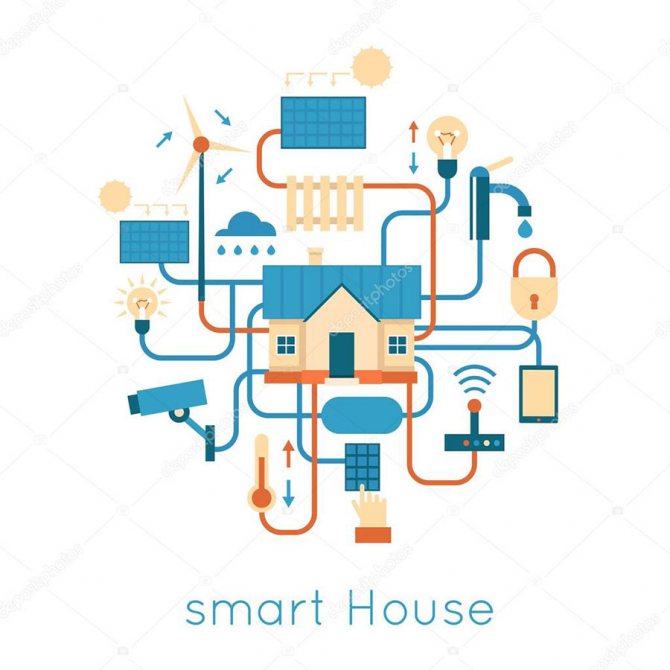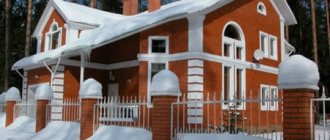We start assembling the system for remote switching on of electrical appliances via the Internet
- Install the free Z-wave Home Mate software on your smartphone or tablet.
It can be downloaded for Apple mobile devices at itunes.apple.com, and for Android devices at play.google.com. For Android tablet owners, the Z-wave Home Mate version is suitable, for smartphone owners - Z-wave Home Mate (Phone).
- Carefully read the instructions for the mobile app, Z-Wave controller and relay.
Instructions in Russian can be downloaded here:
It is more convenient to print these documents in advance so as not to be read from the smartphone screen - you need your mobile device to make settings.
- Connect the Z-Wave controller to your WiFi router.
The procedure is simple. In short, launch the mobile application, scan the QR code on the back of the controller with a smartphone camera and enter the factory password and username specified in the instructions. Then go to the device list screen and click on the controller name. For more details see. And it will help you to cope with the task even faster.
Important! After connecting, be sure to change the factory password of the Z-Wave controller. Password change is a standard security procedure for any smart device connected to the Internet
- Connect the relay to the controller.
To do this, select the “Include device” item in the application: for 60 seconds, the controller will enter the search mode for a new device. Then plug the new relay into a power outlet. The controller will detect it and add it to the network. The relay name will be displayed in the general list of connected devices. Try turning the relay on / off via the app.
Important! When adding a new device for the first time, the controller should be no more than 1 m away from it.After successfully adding to the network, the relay can be connected to any outlet that is no more than 30 m away from the controller
- Connect the heaters to smart relays and try to control them through the app.
Happened? Your system is ready to go! Now, leaving the house to the dacha, just start the program on your smartphone and turn on the heating remotely. In the app, you can program sockets to start and stop automatically at a specified time.
Smart sockets can be used to connect not only heaters, but also other household electrical appliances. And most importantly, the Switching Lite kit will become the foundation of your future smart home. Unlike devices using GSM mobile network and SMS-messages for control, the system based on Z-Wave technology is easy to expand. Just buy sensors for motion, temperature, opening and closing doors and windows, water leaks, alarms, etc. Moreover, you do not have to purchase a SIM card for each module, as required by GSM products. And the convenient and intuitive Z-Wave Home Mate app will help you manage your smart home without any extra hassle.
How to ensure heating control in the Smart Home system
If you try to implement a “smart home” heating system with your own hands, positive effects can be achieved without even combining heating systems under the general control of a computer.
Heating elements and heating units can be equipped with controllers associated with indoor temperature sensors. After that, the heating devices can be set to the operating mode (the order of switching on and off by time or when the temperature reaches a certain value).
The disadvantages of this solution are as follows:
- each such device will have to be configured separately;
- he will not coordinate his work with other systems at home;
- each individual system will not react to temperature changes from the outside, since it simply does not have such data.
A more effective solution is to create a heating system for the room under the control of a single control unit, which can be set to the general operating mode (taking into account the peculiarities of functioning for each group of heating devices separately).
For both simple and combined heating systems, it is a good idea to define the temperature zones by setting separate heating parameters for each of them. A smart home whose heating is configured in this way will heat the living quarters more strongly, give heat to the garage with less activity, and make sure that the temperature in the wine cellar does not rise.
Weather-compensated heating control
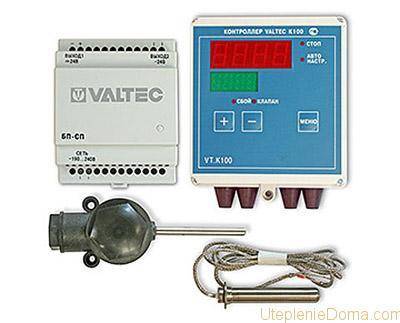
An important link in the "smart home" system is the weather-dependent regulator.
A weather-compensated heating controller is one of the key elements for creating comfort with a smart home. An external temperature sensor allows you to correlate the temperature outside the room and the inside, and then, according to a given curve of this ratio, determine the operating mode without human intervention.
The weather-dependent heating controller will control the heating of the room, responding to changes in the weather outside: increase the temperature evenly when it gets cold, or stop heating if it is hot outside.
Since the weather heating controller reacts to the outside temperature, it can maintain heat according to a preset program and prevent excessive consumption. Smart heating in a country house will lower the temperature when there is no need to heat the premises (if the owners have left).
Integrated heating control in the "Smart Home" system
An integrated approach involves heating control in combination with monitoring the operation of the ventilation system and the water supply system. This allows you to fully maintain a certain climate in the house, taking into account the air humidity and temperature indicators in different rooms.
You can set various operating scenarios for all systems controlled by the "Smart Home", and implement a notification function if any of the subsystems fails.
In addition, you can use mobile communication to give a command to the system. Smart heating of a country house will begin preparing living quarters for receiving guests on such a signal in advance.
Integrated management of heating, ventilation, water supply and electricity in the “Smart Home” system as a result gives and increases energy efficiency (the crisis of energy resources dictates solutions in household construction).
Smart dacha
We want to start with a country house. Although we do not spend much time in it during the season, it is he who is the comfort zone in which we can rest, sleep well and gain strength. If the task is made as easy as possible, then every summer cottage morning will seem even more vigorous and bright.
Let there be light!
Lighting should be convenient and economical, and preferably fully automated. To do this, you can install daylight intensity sensors that enter through the windows, which will send a signal to the common panel, say, in cloudy weather, and the voltage will increase, thereby leveling the illumination. This is no longer just a switch on the wall, thanks to which the room is either light or dark, and not a simple dimmer that needs to be turned for a long time, adjusting the brightness of the lighting, but a completely reasonable mechanism that works from a previously written program.
Lighting can be programmed differently in each room, and it is far from necessary to stop only at correcting the light flux. For example, you can install motion sensors in the bathroom, toilet, pantry.That is, when you are inside this room, the light is on, if you go out and the sensor does not pick up any movement for several minutes, the light goes out.
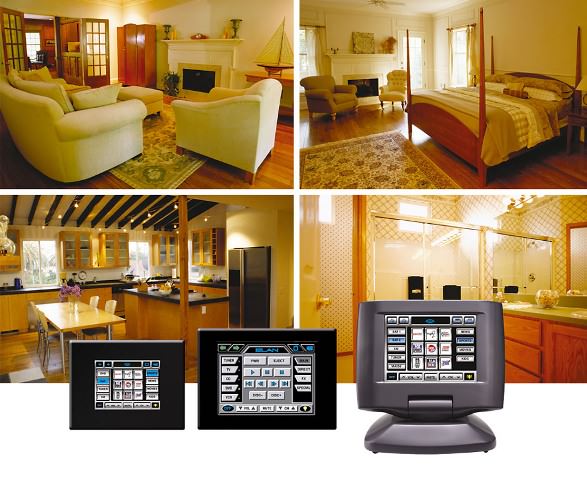

Air conditioning and ventilation
The quality of the indoor air in which we are located often regulates our well-being, and therefore the air must be fresh, clean, and also at a comfortable temperature for humans.
To do this, you can use air conditioning and ventilation systems.
Here are just a few examples of proper air management in a home:
- The hood in the kitchen turns on the moment something is installed on the hob for cooking;
- The hood operates in periods according to a programmed schedule;
- The air conditioner maintains the established microclimate, observing the temperature and humidity of the air;
- The air conditioner regulates the temperature in the house while you sleep. For example, an air temperature of 22-24 ° C is comfortable for a person, but a deeper sleep occurs with a slight cooling to 16-17 ° C. Why not apply such an installation to a smart home system that is aimed at controlling an air conditioner? You can simply program it for periods in which the temperature will change, and every night in the country you will get 100% sleep. And so that in the morning it is not so cold to get up from a warm bed, just before the alarm clock, the temperature can, according to a given program, return the warmer climate to the bedroom again.
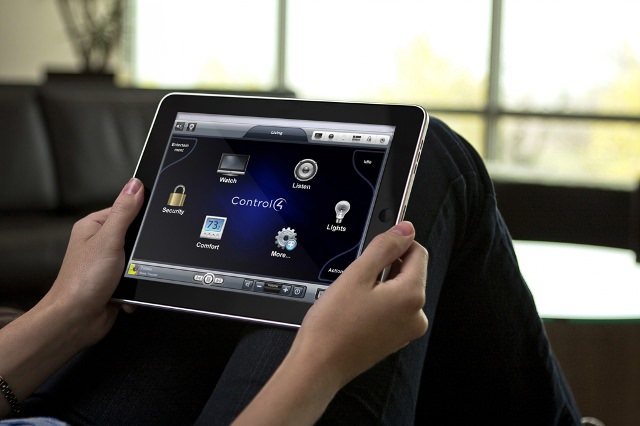

Smart heating of a country house
We have said many times that the house should be warm. For this, we chose a variety of heating devices. With the constant presence in the room, a simple convector or an oil radiator is no longer enough. At a minimum, you will need a boiler for heating.
This is already a fairly reasonable device if you are only considering a mid-range price niche and above. Such boilers are programmed to turn on and off, constantly maintain the set temperature, react to the temperature outside where a special sensor is installed, and equalize the heat inside the house to the desired level in relation to the outside. This is very convenient, especially if you make a remote control. Thus, even the day before arriving at the dacha, for example, to cook barbecue on a snowy and frosty day, you can perfectly warm up the house.
A serious competitor for boilers is radiant heating - panels, films and special equipment that emit infrared rays, which minimize convection and heat the room with high quality, and not just the air inside. This is already a full-fledged participant in a smart home in the country, not even connected to the intelligent control complex.


Household water and sewage management
Here, many summer residents have requirements and are generally underestimated. Well, what can be improved there in the water or sewage system? It runs from one pipe, flows into the other, and that's all. But we want to change this opinion now.
Literally a few modern "gadgets" can change your view of such engineering systems in a country house. For example, if the water pressure in the house is poor, the pump automatically turns on, and now a jet with the required pressure comes from the mixer.
There are also many issues with sewerage, especially in winter. And we will close one now. An ordinary heating cable, which will cost you no more than a small light bulb, will not let the sewer freeze even in the most severe frost, and it will not clog up the moment you arrive at the winter barbecue. Agree, it is easier to eliminate problems than to eliminate them at the most inopportune moment.
Hot water is also worth talking about. But it seems to us that this issue has long been resolved with the help of a heating boiler circuit and a water heater. But here, too, intelligent control is possible - the same maintenance of the required temperature.This will make possible the constant presence of hot water in the storage tank, as well as save energy.
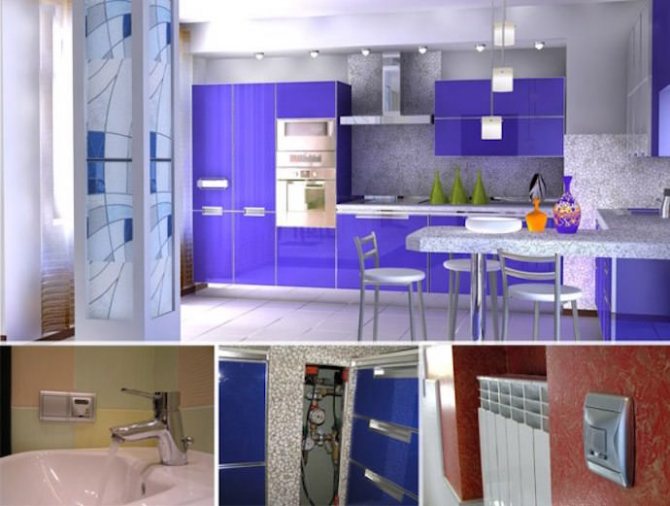

IT, multimedia, modern electronics
It is clear that in the country there is no time to watch TV or look for a good movie for the evening. After a hard day in the garden or in the workshop, you just want to sleep. But there are also evenings that can be brightened up with a classic picture on DVD or pleasant music. Therefore, all modern devices for providing pleasures of this nature can be connected to one control panel, and even easier, to a tablet or mobile phone.
Thus, through wired or wireless communication, you can control anything, any item from a set of household appliances. Microwave, coffee maker, oven and anything else will happily respond to the signal you send.
Only one condition is that the device must be connected to an intelligent system and correctly programmed for one or another action.
Smart home by premises
To complement the positive experience of the increasingly popular automated system today, we decided to offer you a small tour of your own smart home:
- Indoor cameras will record everything that happens in the house at the time of your absence and replay it upon arrival. If necessary, the smart system will simulate your presence in the home - turn on and off the lights in different rooms, music, TV. The curtains will open and let in daylight, or vice versa, prevent the bright sun from waking you up on a weekend. This applies to rooms, and then only to a minimum;
- We pass to the bathroom. The water temperature is always at a set, comfortable level, the hood turns on immediately after taking a shower, drying the walls and partitions, mirror and glass panels by replacing the air. Water sensors on the floor are always ready to send a signal to the smartphone if a sudden rush occurs, and the warm floor regulates the temperature inside the bathroom;
- We go to the kitchen ... morning coffee has already been brewed here, the toaster will soon serve crispy bread, and the ventilation regulates the air purity.
In principle, the essence of the project is clear to everyone, we just wanted to show all its advantages at once. But we will not stop, because from the house we always go out into the street.
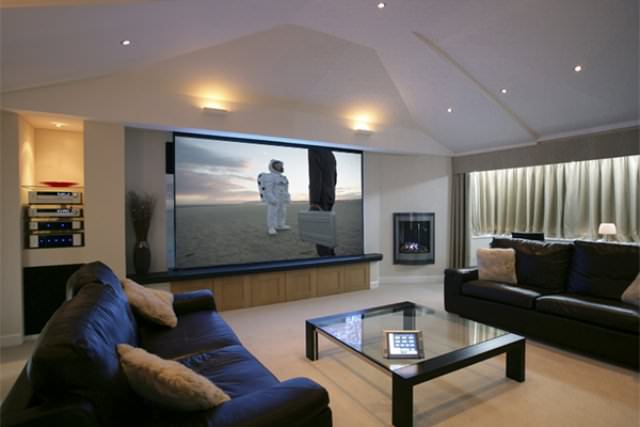

Remote control of complex heating systems
The Polish company Tech Controllers is gaining an increasing share in this market segment, producing a wide range of controllers with remote control capabilities.
By themselves, Tech controllers are multifunctional devices that are the main, basic part of the system, which can remotely control almost any complexity of heating systems using additional modules. There are a lot of possibilities, therefore, using an example, we will consider only the possibilities for remote control.
Installation example of Tech Controllers equipment
The photo used for editing:
1. Controller Tech ST-409n is a multifunctional device designed to control a central heating system, providing:
• interaction with three wired room regulators
• interaction with a wireless room thermostat
• smooth control of three mixing valves
• DHW pump control
• return temperature protection
• weather-compensated control and weekly programming
• the ability to connect the ST-65 GSM module for remote heating control from a GSM smartphone
• the ability to connect the ST-505 module, which allows remote control of the boiler via the Internet.
• the ability to control two additional valves using additional modules ST-61v4 or ST-431 N
• Ability to control additional equipment such as garage doors, lighting or sprinkler, etc.
Different Tech modules can be used for remote control, it all depends on the specific needs of the owner. For instance:
2. Tech Wi-Fi RS module, which allows:
• remotely control the operation of the boiler via the Internet
• view the parameters of all devices in the heating system
• edit all parameters of the main controller
• view the history of alarms and parameter changes
• assign an unlimited number of passwords (for different access levels - menus, events, statistics)
• change the set temperature on the room regulator
• notify owner of alarms by email
3. Ethernet module Tech ST-505
• remote control of the boiler operation via the Internet
• viewing the parameters of all devices of the heating system
• the ability to edit all parameters of the main controller
• viewing the history of alarms and parameter changes
• the ability to assign an unlimited number of passwords (for different access levels - menus, events, statistics)
• changing the set temperature on the room regulator
• alarm notification by email of alarm
The module interacts with the Tech controller wirelessly and allows remote control of the boiler operation from a GSM mobile phone.
• SMS message about each deviation from the preset boiler operation parameters,
• the module sends on demand a message with information about the current temperature on all active sensors. After entering the authorization code, it is also possible to remotely change the set temperatures.
• by SMS and by phone (incoming call) with a message about a malfunction of the heating device.
What if the heating system is so individual that none of the above solutions can fully meet the needs of its owner for its control?
There are no hopeless situations! Most often, the customer himself simply does not understand (and should not!) All the capabilities of modern remote heating control systems. It is really difficult for an unprepared person to understand all this abundance of devices offered on the market, which are completely different from each other in functionality, price, and, of course, quality. And installers, often, simply have no idea about the possibilities for controlling heating systems - their task is to mount the system, but how often you will run around the house (or into the boiler room) and turn various valves to ensure constant thermal comfort, they do not care ... Our specialists more than once had to almost completely redo the "creations" of such craftsmen, and this, believe me, costs a lot of money. Miser pays twice. Contact us, we will advise you for free, and, if necessary, we will install a remote heating control system, we will help with the selection of high-quality equipment at an affordable price.
You will be satisfied working with us!
Remote control of the boiler room using mobile GSM
But what if there is no wired Internet in a country house? How can the heating be controlled in this case?
It's very simple - with the help of a special GSM module and, of course, a mobile phone. In fact, the GSM module plays the role of your personal assistant - you called it, gave the command, for example, to heat it hotter by a certain time in advance - and the whole family will come to a warm and cozy home. Or, on the contrary, you forgot to turn down the boiler power when leaving for work in the morning - no question, you can do this directly from work, via the Internet or directly from your smartphone, while you are still getting to work
The GSM module is a compact device with its own SIM-card of any operator (it is important that it provides reliable signal reception in a given area), which allows you to control the indoor climate from any phone (satellite, mobile or fixed connection), tablet or PC
Depending on the settings made, your phone will receive either short SMS notifications with various information and instructions on changing the settings of the heating boiler, or you will receive phone calls with various information about the operation of the heating system. A special mobile application is installed on the phone (there are versions for Android, and for iOs, and for Windows Phone), which allows you to directly remotely control almost all the parameters of the heating boiler.
The GSM heating control module is essentially a computer docked with external sensors and has the ability to change the operating modes of the heating system. Naturally, the module must be in the area of reliable reception of mobile operators.
The GSM module for the heating boiler GSM-Climate ZONT H-1 is a very interesting solution offered by the Russian company Micro Line, which specially manufactured this device for the company Evan, which produces heating boilers. Immediately, we note that Zont H-1 GSM is suitable not only for Evan boilers, but, in fact, for any heat generators that have appropriate terminals for connecting a room thermostat!
GSM modules in their work, as a rule, use cloud services, so you will always have the opportunity to control or change the parameters of the heating system via the Internet (that is, without sending control SMS or phone calls) using a tablet, personal computer or smartphone, by going to the website of the module manufacturer using your username and password.
GSM heating control module can operate in several modes:
- automatic, when, according to signals from the installed sensors, the controller maintains the specified modes according to the specified program;
- SMS heating control, when the heating system is controlled by sending SMS. In this case, when new data arrives, for example, about the room temperature, the controller accepts them for execution and begins to support them in automatic mode;
- warning, by sending alarm messages about the current state of the house (gas leak, breakthrough of the water supply system, etc.);
- remote control of other devices connected to the GSM module (watering, lighting, alarm, etc.).
GSM - heating control allows remotely:
- receive reports on the room temperature;
- receive notifications about the current state of heating equipment;
- change the operating mode of the system by raising or lowering the temperature, including separately in each room.
Heating control is not limited to these functions. In principle, any heating system can be turned into a remote one. To do this, it must have an automatic mode of operation, and a special GSM controller must be connected to it for heating control and communication with the subscriber.
Benefits of full heating automation
Before discussing the benefits of smart heating, there is a kind of initial disadvantage for the end user.
When arranging a system of this kind, you will have to spend money on the purchase of the required components, as well as on installation and configuration.


Not the most expensive and advanced set of "smart" heating, nevertheless, it allows you to organize a completely effective home automatic control system
The possibility of doing everything with your own hands is not excluded, of course. However, to implement this option, it is necessary to have the status of a highly qualified specialist, or a jack of all trades. But the costs of the system arrangement are ultimately compensated in full.
Average statistical calculations showed up to 30% savings in heating costs during the cold season. Thus, the device "smart" heating pays off in the short term.
Among the clear advantages of the technology is the ability to control all parameters directly from the phone or tablet.
Modern smartphones allow the installation of special applications through which the parameters of the heating system are monitored and adjusted.
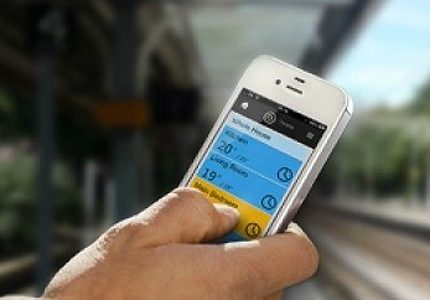

Smartphone and the ability to remotely create a comfortable environment in the home is a reality of modern life. At the same time, it is allowed to control heating from other popular digital devices.
An obvious advantage of such systems is the factor of an accurate and stable temperature background.
Moreover, with the help of the application, you can set the desired mode at a certain time of the day: at night it is cooler for a restful sleep, and an hour before returning from work - a gradual increase in temperature.
When the inside of the room is "not cold - not hot", that is, there is an optimal temperature background for the body, the risk of colds is sharply reduced. In such conditions, the body is in an active phase, the person feels a state of comfort.
The convenience factor is also an advantage. There is no need to turn the taps, measure the temperature with a thermometer. All these actions will be performed with high precision by the automation. In addition, it becomes possible to take into account the consumed energy. And this, again, is savings.
Heating control system elements
The heating control unit is a collection of elements combined into a single circuit. Their selection becomes key to ensure the efficiency of the system. Items may differ in characteristics. The main indicator of their effectiveness is the ability to form multilateral communication between the control unit, the owner and heating elements.


The basis of the system is a special electronic unit with 1 or more slots (sockets) for installing ordinary SIM - cards of cellular communication
Typical complete set of elements of the GSM coordination system with heating:
- connecting wires;
- several temperature meters;
- GSM controller;
- leak detector;
- electronic key scanner;
- access control mechanism;
- antenna for reception and transmission of GSM signal;
- accumulator battery;
- ethernet adapter that provides interaction with other elements;
- pads for connecting to the boiler;
What are the capabilities of remote heating control systems
- normal operation, when the set temperature is maintained throughout the house;
- zone mode, when in different rooms there can be an individual temperature;
- prevention of defrosting of the heating system (freezing of pipes) during the cold season, when you are away from your country house or summer cottage;
- the possibility of turning on the boiler in advance, for example, you need to warm up a country house when you are going to visit it on weekends or holidays;
- always be aware of the operation of your autonomous heating and, if necessary, carry out its diagnostics;
- time mode, in which at different times during the day in the house its own thermal mode can be maintained with a significant reduction in material costs for fuel, for example, you can adjust the boiler to low power (respectively, to low fuel consumption), going to work or on business, and turn on normal mode before returning.
Remote heating control implies that any of these modes, as well as the specific temperature values in the rooms, are changed using a mobile connection, or heating is controlled via the Internet. This approach is part of the ideology of creating a “smart home”, which entails the further development of all engineering systems of the house in order to ensure ease of use and the creation of the most comfortable living conditions.
Which heating system can be remotely controlled?
In country houses and cottages, two-pipe systems with forced circulation of the coolant are currently most often used: the circulation pump pumps the coolant throughout the heating system, which, thanks to the distributor comb, can be supplied to each heating device. In such systems, as a rule, a safety block is used heating system to protect it from destruction in unforeseen situations, for example, in the event of an increase in pressure above the permissible level. It is also necessary to have additional equipment to control the operation of the heating system: sensors, special valves and devices for regulating the flow of the coolant, and it is also necessary to combine various devices into an information network
System start
"Smart home" is, in fact, any automation system for managing various parts of a building; it is an intelligent way to organize a comfortable stay at home. The beginning of her arrangement in the house must begin with an understanding of her work. The operation of the system depends on its main component, which is a computer. It is he who analyzes all the data from different rooms and controls the operation of other devices.
The more detailed a house is equipped with various devices, the more powerful and stable a computer that organizes their work needs to be. This is important in the case when he needs to regulate temperature, light, heating, electrical appliances, and many other devices. In order to start working on creating a system, you need to carry out several points, including:
- Buying a computer;
- Creation of your own website at home, displaying all its functions;
- Installation of special management software;
- Drawing up a scheme of work;
- Launch some functions, starting with the simplest ones.
All this can be done independently or with the help of specialists in this field. In the first, restarting your home is cheaper, but risky. In the second case, it will be possible to get a guarantee for the system, but everything will be expensive. But it's not worth worrying about the fact that the heating of the Smart Home will occur intermittently.
Comments.
| Andrey 03/12/12 93 it is necessary to control heating elements with a capacity of 3 kW. tell me how to connect triacs to BM8036 through standard outputs. |
| Egor 03/12/12 95 Download the instruction, the link to which is at the very beginning of the article, this instruction shows all the necessary schemes. Do not forget the fact that triacs with such a power must be installed on radiators. |
| Andrey 03/12/12 96 I can't understand this instruction. the instructions say: For BM8036, which has no triacs on the board, you need to connect power triacs to the XS5-XS12 outputs. in Appendix 1 BM8036: The electrical circuit of the triacs is. but in Appendix 2 NB8036 they are just not there. |
| Egor 03/12/12 97 So you have NM8036 or BM8036? Appendix 1 is BM8036 and Appendix 2 is NM8036. Their output stages are obviously different. What do you have in the output stages? Check the specification if the board is not clear. How many channels? |
| Andrey 12.03.12 98 I plan to buy BM8036. while I understand everything. do you have triacs in the output stages of the NB8036? the instructions say that there are no triacs on the BM8036 board, although they are on the diagram. this is what misleads me. |
| Egor 12.03.12 99 Yes, there is apparently a mistake in the instructions. You should read: "For NM8036, which has no triacs on the board ...". NM really does not have them either in the circuit or on the board. As far as BM is concerned, I do not presume to judge what is there and what is not. I am working with the NM8036 Timer-Thermostat. |
| Evgeniy 03/29/12 146 Good afternoon !!! I can't figure out how to connect the NM4411 to the NM8036, what should I connect to? |
| Egor 03/29/12 147 The article shows the controller contacts to which the load channels are connected (to enlarge, click on the picture). These pins must be connected to the NM4411 inputs. Each NM4411 has 4 load channels, respectively: 4 inputs. I am using all 12 channels of the controller, so I have 3 NM4411 units. |
| Eugene 03/29/12 148 NM4411 has a contact X6 - common or ground, and with NM8036, which contact to take for the bundle? It's just that I'm very far from radio engineering and even more so from reading circuits !!! Thank you very much for the clear answers !!! |
| Egor 03/29/12 149 Common, ground, minus the power supply, GND - all this is the same wire. My common NM4411 is connected to the minus of the power supply, because it is the same for all consumers. |
| Evgeniy 03/29/12 150 Thank you very much !!! |
| Dmitry 02/04/14 626 Could you give a layout of the printed circuit board that you have under the NM8036 to display all 12 control channels |
| Egor 04.02.14 627 Board drawing https://www.goandsee.ru/_files/plata.jpg Board size 140 x 96 mm. |
| Dmitry 02/04/14 629 Thank you very much |
Pros and cons of heating control system Smart home
Heating control using a smart home allows you to achieve the following:
- the climate in the house or in any chosen room will exactly correspond to the owner's feeling of comfort, in accordance with the program of operation of the heating devices chosen by him;
- automated control of the heating system can significantly reduce energy consumption;
- intelligent control of household subsystems at home will allow them to be monitored remotely and not worry about possible breakdowns (the computer will react to a malfunction).
The disadvantage of such technologies is still availability due to the rather high cost of equipment and installation of the system.
Spending a couple of weekends in the winter at the dacha - what could be better if you want to take a break from the hustle and bustle of the city? And to come to a country house, warmed up in advance to a comfortable temperature, and even more so.
We have already written about why it is advantageous to use a starter for remote heating of a summer cottage with control via a smartphone or tablet. Now let's talk about how to install it yourself. Don't worry: you don't need the help of an electrician, no installation tools, no wires, or special technical knowledge. If you can program, say, a microwave oven with a snooze timer, then you can easily cope with the installation of the Switching Lite kit.
Electric heaters up to 3 kW can be connected to the included smart plug-on relay. They are quite enough to warm up the rooms of a medium-sized country house in two to three hours. Are you ready to try it? Begin!
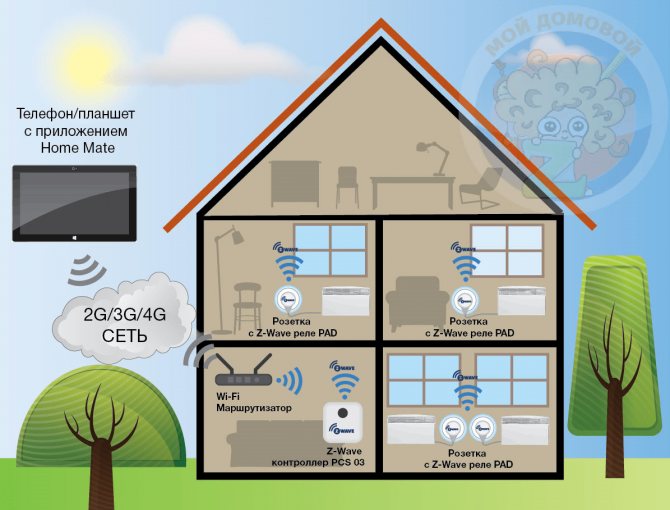

Control scheme for heating devices via the Internet in a country house
Heating control according to weather conditions
This type of "Smart home" and heating control analyzes the main criterion of response for it - the weather outside the window. For its operation, a special sensor is installed on the street. Information from it is transmitted to the control unit, and actions are automatically performed to bring the internal climate in accordance with the established parameters.
The main functionality of such control:
- reduce the level of heating and energy consumption when the outside temperature rises;
- increase the intensity of the heaters during the weather worsening;
- maintain a minimum level of heating during the absence of people living in it, which will significantly reduce the cost of paying utility bills.
Heating controller selection
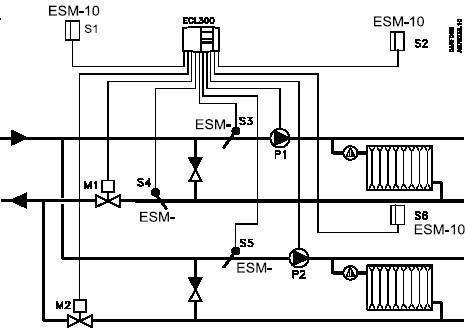

Example of controller wiring diagram
When do you need to install a heating controller? First of all, this device is necessary in case of frequent absences from the house or apartment of residents. By connecting the electronic unit to external temperature sensors (outdoors and indoors) and the boiler control terminals, you can use the built-in software to set up an automatic change in the intensity of the burner operation.
How to choose the optimal controllers for heating systems? The easiest option is to consult a specialist. But it is difficult to find one at this time, as this product is relatively new.Therefore, it is recommended that you first independently study the main selection parameters:
- When comparing a controller for a heating boiler, make sure that the installed equipment has the ability to connect to the control unit. Most often, the boiler is characterized by one-stage or two-stage external control. This applies only to gas models - matching with solid fuel is impossible;
- The number of components to manage. For a Honeywell heating controller, this value can reach 15, depending on the specific model;
- The presence of a GPS unit. As mentioned above - this function makes it possible to remotely control the heating;
- Frequency of software updates. The modern controller of heating and hot water supply systems TRM 32 can be connected directly to the computer. You can always find the latest software version on the manufacturer's website.
An additional function is to regulate the operation of the components according to the set heating schedule. This possibility is provided in the Aries heating controller.
You should also pay attention to the accuracy of the measurements. In professional models, this indicator should not exceed ± 0.01 of the scale
Smart home heat supply with a weather-dependent controller and a regulator
Under the now familiar concept of "smart home" should be understood not only a country house, a house outside the city limits or a house outside the city. An apartment in the city, an office, and many other types of premises will perfectly fit into this awareness. If we consider the heating system from this point of view, then with a similar approach to it, several basic principles need to be implemented. When we say “smart home”, heat supply in this case should provide comfortable living conditions or savings on costs for your own maintenance.
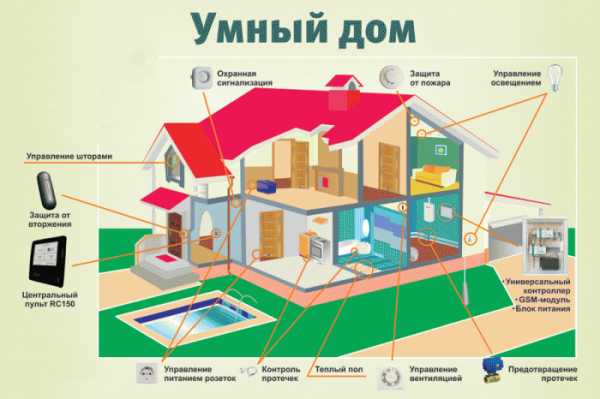

Smart House
- What kind of heat supply can there be?
- How is it organized
It has long been known that comfort is never free. Any attempt to provide ancillary amenities or be freed from unnecessary worries through the use of automation will mean an increase in costs. However, regardless of our desire, for a smart home, heat supply plays an almost important role in the development of comfortable conditions, and the cost of its maintenance in most cases depends on its organization.
In the event that the used equipment, automation and control means are selected and applied correctly, then the heating system - a smart house, living space or car garage it will heat - does not matter, it will be able to provide fuel economy in addition to maintaining the specified conditions.
First, this can be achieved by the mutual action of the heating boiler with the control center. In addition to the availability of personal safety equipment, a boiler of this type has a communication interface, thanks to it, it can be possible to carry out smart heat supply to a country house. In its most primitive form, this should be understood as the fact that a smart home performs heat supply control depending on the temperature reached in the room according to signals from sensors.


Elements of a heat supply control system in a smart home
A good option for similar control is temperature control of the heat carrier. But with all the advantages of such a construction of heat supply, there are other, much better approaches to organizing the work of heating. At this time, weather-dependent heat management is considered promising.
How is it organized
With a similar approach Plus, an external temperature sensor is also applied to the home temperature sensor. As a rule, a weather-dependent heat supply regulator will work with one external sensor, but the use of two makes it possible to achieve more accurate maintenance of the mode and even self-adapt the system.
Weather-compensated controller with thermal converter
The weather-dependent controller of the heating system does not stop working on the basis of the programmed curve of the correspondence of the temperature of the heat carrier to external conditions. In its most primitive form, it looks like this - if it gets colder outside, then the temperature of the water in the system increases, if it is warmer, it decreases.
One of the basic points of the weather control of heat supply can apply a temperature of plus twenty degrees - with it, the temperature of the heat carrier is taken equal to that located around, while the heating is practically turned off.
A similar approach to the organization of heat supply should also provide for zonal management, i.e. in individual places, the temperature must be additionally corrected in relation to a specific one by an external sensor. If, for example, a lot of people gathered in one of the rooms, due to which it became hotter, then the system detects a local increase in temperature relative to that set by the atmospheric heat supply regulator and performs a correction in this zone.
The use of two sensors - outdoor and indoor, in addition to saving fuel, reduces the inertia of the system, which increases its efficiency and will also provide an additional reduction in maintenance costs.
Very often, the most correct choice for the organizational work of heat supply will be the use of heating technologies characteristic of a smart home. In this case, it is possible to achieve both an increase in the level of convenience in the house and savings in the cost of heating it.
The iT500 is lacking No problem Salus iT600 can do anything and more
If you lack the functionality of the iT500 to control only two heating zones, then our website presents a more functional multi-zone (there are wired and wireless versions) Salus iT 600 Smart Home system. Well, what, and its capabilities for remote control of heating (and not only!) Will be enough for even the most demanding consumer!
iT 600 Smart Home combines the ability to control warm water floors, remote control of heating using thermostats, single switching at the “smart home system” level, changing the temperature in each room using a smartphone with Internet access, control and management of any electrical devices in home, connecting sensors for opening windows and doors and many other functionalities. The system far outstripped not only its competitors in the field of remote heating control, but also set the trend in the field of automation and dispatching of engineering systems for many years to come!
Attention! The new Salus iT600 Smart Home product line is already on sale!
Now you can not only remotely control the heating, but also guard the house and control electrical appliances!
Buy heating control system SALUS iT600
Now you have the opportunity to buy Salus iT600 Smart Home - a new line of automation for the Smart Home!
This is the same full-fledged system for remote heating control via the iT600 Internet plus additional features:
- application of the universal Internet gateway Smart Home UGE600, which now supports up to 100 wireless devices of the ZigBee network and is used to replace last year's version of the Salus G30 gateway.
- control and management of various electrical appliances. connected to smart sockets Salus SPE600 with the ability to meter the consumed electricity
- connection and control of security alarms using wireless sensors for opening doors or windows Salus OS600 Door Sensor
- managing your system is now even more convenient. thanks to the new Salus Smart Home application for smartphones on iOS and Android, the interface of which and registration of devices have become much easier and more intuitive!
All system components are wireless devices operating in the modern ZigBee home network standard, now you can create separate groups of devices that work in one bundle and which can be assigned individual tasks.
In the future, the company's engineers intend to expand the capabilities of the smart home control system, but now you can buy Salus iT600 Smart Home, starting with the bare essentials, and build your Smart home at a very attractive price!
And what about the owners of outdated heating systems?
Tech WiFi 8S is one of the newest and most functional models of thermostats from the Polish company Tech Controllers (Polish version of the name Tech Sterowniki), on the basis of which you can build a multi-zone radiator heating control system for your home. For example, in a country house or in a country house, the heating system was installed many years ago. Naturally, a distributor comb was not provided, there are no three-way mixing valves, there is, in principle, no possibility to control something. Until recently, the only way out of this situation was to install mechanical thermal heads on radiators. Such a solution has the right to exist, but, firstly, the accuracy of temperature control is several degrees, and secondly, you need to adjust these very thermal heads on each radiator separately, in the morning and in the evening. Troubled and inconvenient. Fortunately, electric thermal heads with high measurement accuracy have appeared on the market. Tech Controllers went even further and offers you a whole system that controls battery-powered thermoelectric servos over your home Wi-Fi network in accordance with preset settings. And now even the owners of outdated heating systems have an opportunity for a comfortable stay!
Tech WiFi 8S can control the temperature in 8 rooms, each of which can have up to 6 thermal actuators! In addition to controlling thermoelectric drives, the controller can also control the boiler: when the set temperature is reached in all rooms, it will turn off the boiler using a "dry contact".
Buy heating control system TECH WiFi-8S
Smart home heating circuit and control systems, photo and video
A smart building underneath implies a resource-efficient office or retail structure that is practical and correct in using all the sources of living improvement that are used. Smart home - heat supply, electrical energy and more, as well as a moderate effect on the external environment.
In other words, a building of this type is distinguished by the ideal production, storage and management of energy in a domestic project. Today, resource-efficient houses can be not only country houses, houses outside the city or equipped summer cottages, but also traditional apartments.
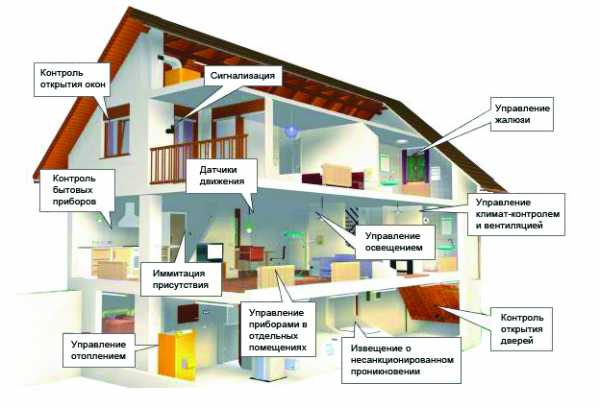

Smart home system type
In conditions of sharp temperature changes throughout the year, the issue of heating the residential premises is quite important. The majority of residents complain that during cold weather, heating radiators provide very little heat, and when the heat comes, they heat to the fullest. In the end, what happens is that people overpay for what they don't need. If your heating system is in order, but you are not familiar with this not very pleasant phenomenon from hearsay, then it will not be superfluous for you to learn about how the heating system in a smart home can be equipped.
Smart heating specifics
The very concept of a smart home in relation to heat supply implies a comfortable living of a person in a stably warm room with low price costs. This means that the heating system should also be arranged so that there is no need to pay again for what you do not use. However, for any arrangement, especially profitable heat supply and resource-efficient, it is precisely necessary to invest financially - but nevertheless, one must not forget that such a decision will soon be fully justified!
So, the use of automation for the operation of the heating system of a smart home is the basic principle for creating comfortable living conditions, and also for saving fuel when the automation itself, along with the control components, is correctly selected and used.A similar situation can exist with the joint productive activity of the heating boiler with the governing center: with the help of the communication interface and the boiler safety toolkit, the heat supply is realized.


Heating circuit for a smart home
The system itself changes the temperature of the heat supply, looking at the indicators from specialized sensors in the room.
In particular, this option is suitable for a country house. The optimal solution here is considered to be the temperature regulation of the heating heat carrier.
Promising direction in the organization
On the other hand, there are many other ways to organize heat supply in a smart home. For example, the system may be dependent on the weather outside the window. This approach assumes the presence of not only a sensor designed to measure the temperature specifically in the room, but also a sensor focused on the external temperature indicators. It is best to use two external meters to accurately maintain the operation of such heating.


Control circuit
The operating principle of the corresponding controller is the dependence of the temperature of the heat carrier on the weather. In other words, when the cold comes outside the window, the water in the system heats up, and when the outside is hot, it freezes. A mark of +20 on the Celsius scale can be taken as a base point for the heat carrier, so that at it the temperature of the system is figuratively equal to the external one, and the excess heat output and heating of the premises ends.
In order to bring the level of comfortable heat supply in a smart home closer, it is possible to adjust the heating so that the temperature of the apartment has local characteristics. In other words, in individual places it can be corrected in relation to the one set by the external sensor. If there are a lot of people in one of the rooms who, for real reasons, heat the room, the system can calculate the increase in temperature in this zone, compare it with the one set on the weather regulator, and then divide the heat around the apartment relative to adjusting the indicators in this room.
Similarly, the provided arrangement of the heating system in a smart building can be definitely called a promising direction for creating comfort in your home and also reducing the money costs for paying for heat supply.
Didn't know the answer to your own question? Ask our expert: Ask
How is the heating system Smart home
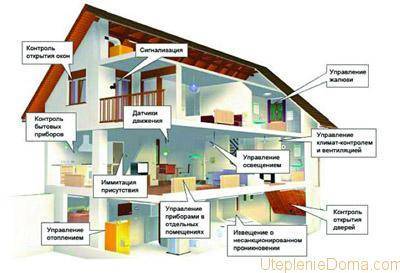

An approximate diagram of the "smart home" system
The thermal conductivity of walls and ceilings, the quality of the windows, the presence of drafts and air humidity, the type of heating system and the way heat is supplied all affect the indoor climate.
Modern heating systems can be functionally different: these are classic radiators, and "warm floors", and. In country houses, individual boilers are installed for heating and providing hot water, while a boiler can be used in an apartment.
All this can be controlled by a single system, which is called "smart home". It is a control computer unit associated with home appliances and indoor and outdoor temperature sensor systems. In accordance with the information of the sensors and the set mode, such a system is capable of lowering or increasing the temperature in the room. In addition, it can regulate the amount of hot water ready for use in the boiler.
Smart roof
The roof of the house can also be included in the intelligent system. This is a large combined area that can be quite useful.
Initially, I would like to recall the green roof, the very plant one about which there is a lot of speculation among modern summer residents. This one works great in support of many landscape styles, and it just pleases the eye. The roof of the house can be heated to keep plants green for longer, even in late autumn.
But heating the roof of a country house is needed not only for plants, because the roof can be standard. In this case, the heating system will work to prevent icing, mountains of snow on the roof and dangerous icicles.
On the roof of the house, as at the highest point, you can install wind turbines that will convert wind energy into electricity. This is already the most natural smart home system. Yes, this energy may not be enough to completely disconnect from the mains, but significant cost savings are possible due to it.
The roof can also serve as a base for solar panels, which is also very interesting.
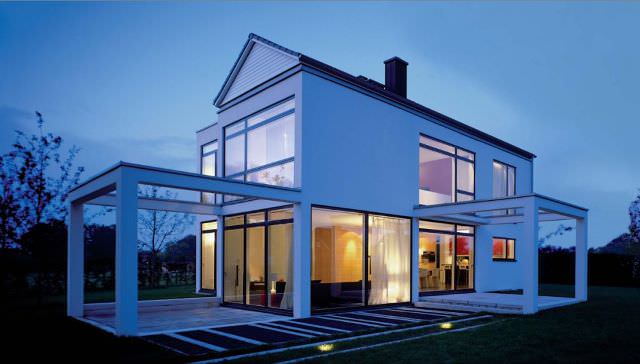

Heating control devices
Programmers and thermostats
The key parts of a heating control system are thermostats and programmers. They are electronic devices, in some modifications equipped with a control panel, which helps to control the functioning of the boiler. In addition, such a device allows you to synchronously change the indicators in two connected components.
In addition, an additional function of the programmers is adjustment via SMS from a cell phone or commands transmitted over the Internet.
A suitable modification of this device can be selected by a set of basic characteristics, which may include:
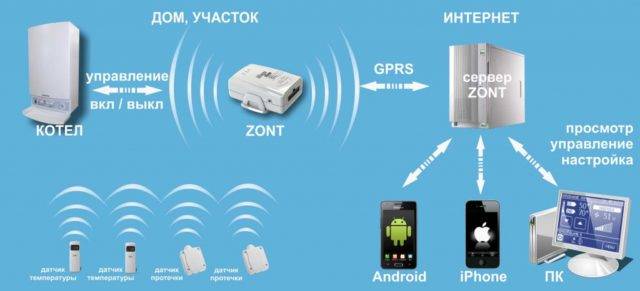

Management via the Internet is carried out in the same way, only through a different communication channel between the homeowner and the electronic unit in the house.
- remote communication between components using radio transmitters;
- the operation of radiators (depending on the settings) can be in a comfortable, normal or economic mode;
- the number of connected circuits can be increased by connecting additional modules;
- heating control by mobile phone;
- data transmission via SMS, etc.
These functional features make the presented elements quite convenient and in demand.
Zone devices
Such heating control elements are installed directly on radiators and boilers. In this case, the regulation by the system is carried out via the Internet connection. These devices are represented by electronic thermostats. They are able to change the temperature of the water in each individual battery or system as a whole. The differences between these thermostats are ease of installation and affordable price. At the same time, the complexity of the system device is reduced, especially since they do not require a separate control cabinet. Zone devices allow the use of several thermostats that are connected to one control unit.
Remote heating control modules
The function of remote control of the heating network can be provided by special modules included in the package with shut-off and control valves and programmers.
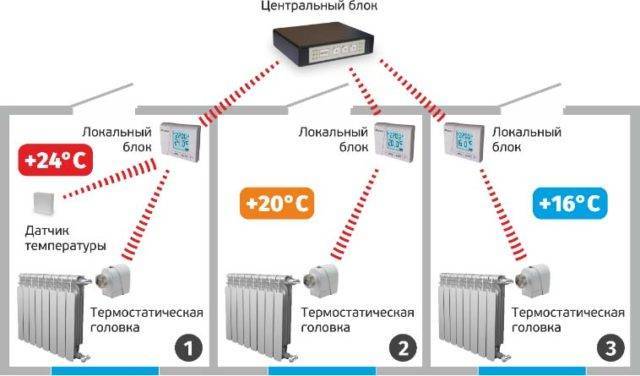

The number of additional device functions is limited by the number of connected sensors and executive relays of the electronic heating control unit itself










